Lösung 3.2:2e
Aus Online Mathematik Brückenkurs 2
(Unterschied zwischen Versionen)
K (Robot: Automated text replacement (-ä +ä)) |
|||
| Zeile 1: | Zeile 1: | ||
| - | Wir schreiben die gesuchte komplexe Zahl <math> z </math> mit ihrem Realteil und | + | Wir schreiben die gesuchte komplexe Zahl <math> z </math> mit ihrem Realteil und Imaginärteil. Nach Aufgabenstellung ist der Realteil <math> x </math>, den unbekannten Imaginärteil nennen wir <math> y </math>. |
{{Abgesetzte Formel||<math>z = x + i y </math>.}} | {{Abgesetzte Formel||<math>z = x + i y </math>.}} | ||
| Zeile 9: | Zeile 9: | ||
Also soll gelten | Also soll gelten | ||
{{Abgesetzte Formel||<math> x = x + i (1-y) </math>}} | {{Abgesetzte Formel||<math> x = x + i (1-y) </math>}} | ||
| - | und das ist | + | und das ist äquivalent zu |
{{Abgesetzte Formel||<math> 0 = i (1-y) </math>.}} | {{Abgesetzte Formel||<math> 0 = i (1-y) </math>.}} | ||
Version vom 10:35, 16. Sep. 2009
Wir schreiben die gesuchte komplexe Zahl \displaystyle z mit ihrem Realteil und Imaginärteil. Nach Aufgabenstellung ist der Realteil \displaystyle x , den unbekannten Imaginärteil nennen wir \displaystyle y .
| \displaystyle z = x + i y . |
Es soll also gelten
| \displaystyle x = i + \overline{z} = i + (x -iy) = x + i (1-y) . |
Also soll gelten
| \displaystyle x = x + i (1-y) |
und das ist äquivalent zu
| \displaystyle 0 = i (1-y) . |
daher ist \displaystyle y=1.
Also besteht unsere Lösungsmege aus allen komlexen Zahlen deren Imaginärteil 1 ist.

